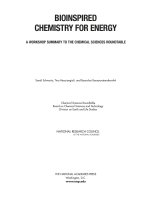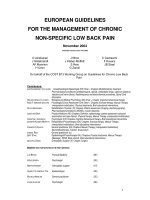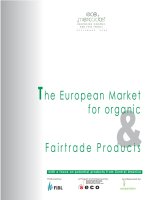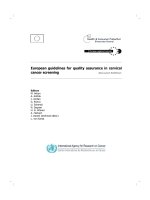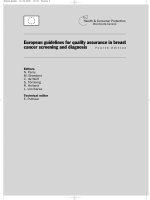European chemistry for growth
Bạn đang xem bản rút gọn của tài liệu. Xem và tải ngay bản đầy đủ của tài liệu tại đây (3.88 MB, 186 trang )
European chemistry for growth
Unlocking a compeve, low carbon and
energy ecient future
Supported by
ii
European chemistry for growth
Unlocking a competitive, low carbon and
energy efficient future
Cefic commissioned Ecofys to perform analyses and bring forward key conclusions and
recommendations from their independent viewpoint, in close collaboration with the sector
iii
Foreword
Cefic initiated a roadmap to explore the impact, opportunities and risks of various energy and
technology development scenarios for the European chemical industry in the timeframe from 2020 to
2050. Cefic commissioned Ecofys to perform analyses and bring forward key conclusions and
recommendations from their independent viewpoint, in close collaboration with the sector.
This Roadmap shows that products of the chemical industry are used in all sectors of the economy.
This makes the industry a powerful engine for innovation and sustainable development. Realising our
potential, we will continue to work with our value chain partners and other stakeholders to develop
the chemistry to enable innovative energy efficient and low carbon solutions.
For this to happen, a complete chemical industry value chain from basic chemicals to consumer
products is needed in Europe. Today this is seriously at risk. In a persisting situation of continued
fragmentation, a policy shift towards reducing rather than further increasing EU energy and policy
costs is urgently needed to ensure the competitiveness of the European chemical industry.
The chemical industry has a long track record of improving its energy and resource efficiency,
thereby lowering its greenhouse gas emissions intensity. It is recognised that innovation is crucial to
ensure further improvements and develop breakthrough technologies that enable a low carbon and
energy efficient European chemical industry.
European and national policy makers have a key role to play towards an innovation-friendly
environment in which European industry can thrive, ideally in a global level playing field. It is
essential that the energy and climate policy framework in the EU stimulates sustainable and efficient
growth. Under these conditions, innovations and investments that can mitigate global emissions will
deliver their full potential.
We believe in the future of the chemical industry in Europe and its capacity to create wealth and
provide healthy living and high-quality jobs. A thriving chemical industry is an essential part of the
solution for the challenge of climate change. We invite you to explore Europe’s energy and climate
future with us.
Kurt Bock - President of Cefic and CEO of BASF
Tom Crotty - Chairman of Cefic Energy programme council and Group Director - INEOS
A special acknowledgement goes to Jacques van Rijckevorsel - Former Chairman of Cefic Energy
programme council and Member of the Executive Committee of Solvay, for his inspiring contribution
to the study.
iv
Executive summary
The chemical industry has a crucial role in Europe’s transformation to a more energy efficient and low
carbon future. The opportunities the sector offers and the challenges it faces are explored under four
scenarios investigated in this Roadmap. Key findings are:
1. Products of the chemical industry enable significant energy efficiency improvements
and greenhouse gas emissions reduction in all sectors and are needed for Europe’s
transformation to a low carbon economy. This enabling effect is likely to grow in the future. The
2010 production of the European chemical industry is estimated to contribute to over 1.5 billion
tonnes of avoided greenhouse gas emissions during product use, equivalent to roughly 30% of
the total European greenhouse gas emissions in 2010.
2. The competitiveness and growth of the European chemical industry value chain and its
ability to attract investments will be damaged by isolated actions in terms of climate
and energy policies, leading to rising costs for European operations:
Current energy and feedstock price differences with key competing regions outside
Europe jeopardise the global competitiveness of Europe’s chemical industry and the value
chain it supports. These differences are due to energy prices and policy costs. Limiting fuel
mix choices, including restrictions on exploiting unconventional gas in a sustainable way,
would worsen Europe’s disadvantage, hamper investments and could limit the development
of some crucial greenhouse gas emission abatement options.
Increasing differences in policy costs in a continued, fragmented policy framework
are estimated in direct CO
2
costs alone at € 1.7 billion per year in 2030 and € 3.1 billion in
2050 for the European chemical industry. This poses a threat to the competitiveness of the
European chemical industry and its ability to meet the growing demand for chemical products
with production in Europe. Unilateral European climate action to reduce greenhouse gas
emissions by 80–95% in 2050 compared to 1990 would have a further deteriorating effect on
production in Europe and the resultant trade ratio. The level of greenhouse gas emissions
reduction achieved in Europe would, in case of increasing imports, be achieved at the
expense of increased emissions elsewhere. There would be no overall reduction in global
greenhouse gas emissions or even a potential increase.
3. Fragmentation of policies and isolated EU approaches will reduce the European
chemical industry’s potential for energy and greenhouse gas efficiency solutions and
might increase global greenhouse gas emissions. Between 1990 and 2010, the European chemical
industry was able to achieve an absolute greenhouse gas emission reduction of 50% as estimated
previously and attract investments. Energy efficiency improvements will continue to
contribute the most to future reduction of greenhouse gas emissions. N
2
O abatement and
changes in the fuel mix for heat generation are other important options available to the chemical
industry itself. All above options rely on further innovation and can achieve a greenhouse
gas emissions reduction of 15 to 25% by 2030 compared to 2010 levels. Under a level playing
field scenario, the European chemical industry could meet the growing demand for chemical
products with production in Europe at a reduced greenhouse gas emissions intensity. However, it
v
should be noted that the emissions intensity is higher under a continued fragmented policy
framework due to, among other reasons, a limited growth of the industry from relocation of
production to outside of Europe.
4. Deeper greenhouse gas emissions reduction is technically possible by decarbonisation of
the power sector and, in addition, for the 2030–2050 timeframe, by carbon capture and storage
applied to emissions from the chemical industry. These options are costly and require
technological breakthroughs. They face several barriers that are largely outside the control of the
chemical industry.
It is essential that the energy and climate policy framework in the EU stimulates sustainable and
efficient growth. Under these conditions, innovations and breakthrough technologies that can
mitigate global emissions will deliver their full potential. A stable and predictable policy framework,
dynamic enough to adapt to a changing global energy and climate policy outlook, will create
increased certainty for business to undertake the path to a more energy efficient and low carbon
future.
Products of the chemical industry are important for all sectors of the economy to increase
their energy efficiency and reduce greenhouse gas emissions. This enabling effect is likely
to grow in the coming decades.
While the chemical industry is a major energy user, responsible for about a quarter of industrial final
energy use in Europe, its products help to save energy and reduce greenhouse gas emissions when
they are used. Chemistry enables energy saving solutions in all sectors of the economy. A few
examples, amongst many, are chemical solutions for insulation and efficient lighting in the buildings
sector, lightweight materials for use in the transport sector as well as materials for wind turbines and
solar cells for renewable energy generation. The products manufactured by the European
chemical industry in 2010 are estimated to contribute to over 1.5 billion tonnes of avoided
greenhouse gas emissions during their use. That is equivalent to roughly 30% of the total
European greenhouse gas emissions in 2010.
This enabling effect is likely to further increase, because there is still untapped potential to apply
existing solutions and there are new low carbon technologies entering the market. Examples of
products already in the commercialisation phase are vacuum insulation panels to reduce energy use,
advanced solar cells for renewable power generation, and innovative packaging solutions that reduce
food waste. A further shift to nitrate based fertilisers will reduce emissions from fertiliser use in the
agricultural sector.
The European chemical industry will continue to seek enhanced cooperation with other stakeholders
along their value chain to foster development and greater uptake of these solutions, to realise energy
and greenhouse gas emissions savings. Also, the industry will continue to contribute to further
developing methodologies to quantify the contributions chemicals make to energy savings and overall
greenhouse gas emissions reduction along the value chain.
vi
A range of current and future technologies is available to the European chemical industry
to continue its long track record in energy efficiency and emissions intensity improvements.
Growth and innovation are essential to achieve deep net greenhouse gas emissions
reduction in the decades to come.
The demand for products of the chemical industry will continue to grow, driven by economic growth
and the innovative solutions that the chemical industry provides. A competitive global level playing
field in terms of energy and policy costs results in a European chemical industry that can meet the
growing demand for chemical products from a growing European production capacity. The energy
intensity per unit of sales could decrease by about 25% in the period between 2010 and 2030 and
further afterwards. This results in constant level energy use in the period up to 2030 and a slight
increase towards 2050 (Figure 1a).
Figure 1a Final energy use and energy efficiency improvements from 2010 to 2050.
Energy efficiency limits the absolute growth of energy use
0
1,000
2,000
3,000
4,000
5,000
6,000
7,000
2010 2020 2030 2050
Reduction due to energy
efficiency improvement
Final energy use
Source: Ecofys
Level Playing Field
PJ / year
Upper line: energy use with
projected production and 2010
intensity
Lower line: energy use with
energy efficiency improvements
vii
Figure 1b Greenhouse gas emissions and contribution of greenhouse gas emissions
reduction options from 2010 to 2050. A range of options can contribute to
the greenhouse gas emissions reduction for the European chemical industry
From Figure 1b it can be concluded that there are several routes to achieving greenhouse gas
emissions reduction under a level playing field scenario:
1. Ambitious energy efficiency improvements could reduce greenhouse gas emissions by about
35% in 2050 as compared to a situation without further greenhouse gas intensity
developments beyond 2010 (i.e. the upper line in figure 1b). There are, however, significant
differences in the energy efficiency potential between the different subsectors, regions and
chemical sites depending on, for example, actions already undertaken.
2. Changes in the fuel mix for heat generation used to meet the heat demand for chemical
processes (e.g. a further shift towards natural gas or biomass) would contribute to a further
reduction of about 10% by 2050 as compared to a situation without greenhouse gas intensity
improvements beyond 2010. Part of this greenhouse gas emissions reduction could be offset
by greenhouse gas emissions in the cultivation of the biomass concerned.
3. N
2
O emissions, a greenhouse gas emitted in the production of nitric acid and some other
chemical products, will become close to zero. This option offers a similar potential as changes
to the fuel mix for heat generation to reduce greenhouse gas emissions in the chemical
industry towards 2050.
The above three options together, which remain under control of the chemical industry itself, have
the potential to reduce the emissions intensity by 40% in 2030 and 55% by 2050 as compared to a
situation without further improvements in the greenhouse gas intensity beyond 2010. These options
would reduce greenhouse gas emissions by 15% in 2030 compared to absolute 2010 levels
with stabilisation around these levels towards 2050, building on an achieved reduction of 50%
in 2010 compared to 1990 as previously estimated in other studies.
Greenhouse gas
emissions
0
100
200
300
400
500
600
2010 2020 2030 2050
Energy efficiency
improvement
Fuel mix change
N2O abatement
Decarbonising electricity
production
Carbon capture and
storage
Source: Ecofys
Mt CO
2
e / year
Level Playing Field
Upper line: greenhouse gas
em issions with projected
production and 2010
intensity
Lower line: greenhouse gas
em issions with emission
reductions
Reductions of greenhouse
gas emissions due to
viii
The Roadmap results show that less reduction in greenhouse gas emissions intensity of the European
chemical industry would be realised with a continued, fragmented policy framework. Under such
policy conditions, reductions in greenhouse gas emissions intensity would be approximately 30% in
2030 and less than 50% in 2050 compared to 2010 (Figure 1c). The reduction in greenhouse gas
emissions intensity is less in this scenario compared to the level playing field due to, among other
reasons, a limited growth from relocation of production to outside Europe. Higher absolute
greenhouse gas emissions reduction would be achieved by these options in Europe under such and
other scenarios of fragmented action, up to 25% absolute greenhouse gas emission reduction in 2030
compared to 2010. However, this would happen at the expense of relocation of production to outside
of Europe, with no overall reduction in global greenhouse gas emissions or even a potential increase.
Figure 1c Greenhouse gas emissions and contribution of greenhouse gas emission
reduction options from 2010 to 2050 under a continued fragmented policy
framework. Reductions in greenhouse gas emissions intensity are less when
compared to the level playing field scenario in Figure 1b
4. Deeper reductions in greenhouse gas emissions are possible by decarbonising the electricity
production in Europe and by carbon capture and storage (CCS) applied to emissions from the
chemical industry. These options are costly and require technological breakthroughs. They
face several barriers that can, to a more limited extent, be steered by the chemical industry
itself. For CCS, these barriers include the lack of public acceptance, large infrastructure
requirements and questions around the feasibility and cost effectiveness of the technology for
smaller, dispersed emission sources. Decarbonising the electricity sector comes with
challenges related to grid and other infrastructure requirements to incorporate a large share
of intermittent renewable electricity sources.
This Roadmap did not quantitatively assess the end-of life emissions outside the chemical industry
related to the use of fossil feedstock. But it did assess the options to reduce the fossil feedstock
Greenhouse gas
emissions
0
100
200
300
400
500
600
2010 2020 2030 2050
Energy efficiency
improvement
Fuel mix change
N2O abatement
Decarbonising electricity
production
Carbon capture and
storage
Source: Ecofys
Mt CO
2
e / year
Continued Fragmentation
Upper line: greenhouse gas
em issions with projected
production and 2010
intensity
Lower line: greenhouse gas
em issions with emission
reductions
Reductions of greenhouse
gas emissions due to
ix
requirement. This roadmap identifies potential for bio-based feedstock and increased use of recycled
products.
All the options described above rely on innovation, which is crucial to achieve deep greenhouse
gas emissions reduction and continued energy efficiency improvements globally. Important research
areas for the chemical industry include advanced biomass conversion processes, process
improvements, and the utilisation of carbon dioxide as raw material (Carbon Capture and Utilisation,
CCU). No quantitative estimates were made for the potential of CCU, it is still in very early stage of
development. The chemical industry can and will deliver breakthrough technologies from a European
manufacturing base, but only if Europe remains a competitive place attracting investments.
The competitiveness and growth of the European chemical industry value chain and its
ability to attract investments will be damaged by isolated actions in terms of climate and
energy policies, leading to rising costs for European operations
Differences in energy and feedstock prices as well as energy and climate policy costs between Europe
and the rest of the world determine whether growing demand for chemical products will be met by
production in or outside of Europe. Current energy and feedstock price differences with key
competing regions outside Europe jeopardise the competitiveness of Europe’s chemical industry and
the value chain it supports. If such differences were to persist, and in addition, policy cost differences
were to further increase, for example due to policy-related levies on electricity prices in the EU and
unfavourable EU emissions trading system rules, this would result in a negative trend in the trade
balance for basic chemicals and lead to significant carbon leakage. The direct CO
2
costs under a
scenario of a continued, fragmented policy framework are estimated at € 1.7 billion per year of direct
CO
2
costs alone in 2030, rising to € 3.1 billion in 2050. This even excludes CO
2
and other policy costs
passed on via the electricity bill.
The European chemical industry would, in this case, go from a positive to a negative trade ratio
between 2030 and 2050. Such a scenario would see no further growth in production for
Petrochemicals in Europe. Imports would further increase in the timeframe beyond 2030, despite
growing demand for chemical products. There is a strong value chain integration between the
energy-intensive basic chemical industry and the less energy-intensive parts where basic chemicals
are used. Weakening the competitive position of the basic chemical industry will also negatively affect
the other parts of the chemical industry.
The extreme case of a strengthened, unilateral decarbonisation by Europe without global action could
lead to very high energy and climate policy cost differences between Europe and the rest of the world.
This would have a strong deteriorating effect on production and trade balance for the energy-
intensive parts of the chemical industry in Europe (Figures 2a and 2b). Under such a scenario, the
energy-intensive subsectors will have lost their trade surplus between 2020 and 2030. Between 2030
and 2050, production would start to decline, due to a lack of investment and potentially even
divestments in Europe. Europe would then import the greenhouse gas emissions related to its
demand for chemical products. Absolute greenhouse gas emissions reduction in Europe, required by
x
the unilateral targets would be achieved at the expense of lower production in Europe and increased
emissions elsewhere, with no overall reduction of global greenhouse emissions or even potentially an
increase.
Figure 2a EU demand for and production of chemical products (expressed in 2010 € of
sales). All scenarios show rising demand for chemical products. However,
production substantially shifts outside Europe in the absence of a level
playing field
Figure 2b Net trade ratio expressed as net export as % of demand. Unilateral action
will result in significant import dependence for chemical products with no
overall reduction of greenhouse gas emissions
0
200
400
600
800
1,000
1,200
2010 2020 2030 2050
Demand under the
scenarios studied
Production assuming
a global level playing
field
Production assuming
a unilateral EU
climate action
Billion of 2010 € / year
Source: Ecofys
-30%
-20%
-10%
0%
10%
20%
30%
2010 2020 2030 2050
Net trade ratio
assuming a global
level playing field
Net trade ratio
assuming a unilateral
EU climate action
Net trade ratio
Source: Ecofys
xi
The competitiveness of the European chemical industry is seriously threatened in the absence of a
global level playing field in terms of energy and policy costs. Figure 2a shows that with an increasing
demand for chemical products over time, the level of European production will be retained in Europe
under a global level playing field, whereas unilateral climate action would move production elsewhere.
The European chemical industry is looking for measures that ensure comparable policy costs in the
key economic regions. These measures should ensure that greenhouse gas emissions reduction takes
place at the lowest possible cost. With globally converging energy and policy costs, the European
chemical industry will continue to attract investment and keep a positive overall trade balance over
time. This would result in employment and value creation.
The energy and climate policy framework in the EU should stimulate sustainable and
efficient growth of the chemical industry in Europe to attract investment and enhance
future innovations.
The current policy framework in Europe poses threats to the competitiveness of the
European chemical industry. It thereby undermines its ability to attract investment and to provide
further innovative solutions to increase energy efficiency and reduce greenhouse gas emissions. The
EU emissions trading system, with an ex-ante allocation, limits the efficient growth of the
manufacturing industry in Europe. Non-harmonised and restricted compensation for increased
electricity costs creates differences in competitiveness between EU Member States. Sometimes,
non-coordinated or excessive support for renewable energy may result in significant cost burdens to
industry.
Energy security, competitive energy prices and climate protection are all important pillars of
European policy. However, the current EU energy and climate framework drives up energy related
costs and generates uncertainty for needed investments. Limiting fuel mix choices, including
restrictions on exploiting unconventional gas in a sustainable way, would worsen Europe’s
disadvantage and hamper investments and could limit some crucial greenhouse gas emission
abatement options.
The chemical industry in Europe calls on policy makers to provide a policy framework that supports
sustainable and efficient growth of the European industry:
Europe should continue its efforts towards global rather than unilateral action against climate change.
In the absence of a global climate change agreement, the design of the carbon market and further
climate policy post-2020 should be further improved to promote efficient production and production
growth in Europe. Measures to support the competitive position of the European chemical industry
should be stable, predictable and coordinated across Europe. They should also avoid unnecessary
cost burdens to European industry. Furthermore, the framework should be designed to incentivise the
innovations required for deep greenhouse gas emissions reduction.
A truly European energy policy should be developed, including fully integrated and well-functioning
electricity and natural gas markets. This should guarantee a diverse and more competitive energy
supply in Europe and allow for sustainable exploration of new forms of energy, such as
xii
unconventional gas. Renewable energy support schemes should be simplified and more coordinated
across Europe. Policy makers should direct the energy portfolio towards cost-effective renewable and
alternative energy options that can serve our energy needs without excessive additional back-up
capacity and infrastructure costs.
The policy framework should take into account the role of the chemical industry in enabling energy
efficiency and economy-wide greenhouse gas emissions reduction. Sustainable consumption should
be further incentivised, focusing on the full life cycle performance of products and applications, taking
on board the latest developments in methodologies.
Research and development support for innovation should facilitate new breakthrough technologies in
pre-competitive phases and should focus on innovative solutions across the borders of individual
sectors. Cross sector cooperation is vital in the field of further energy efficiency improvements and in
the area of new innovative product solutions.
The policy package should enable market-oriented, cost-efficient technologies. It should help to
overcome barriers such as public acceptance to and regulatory uncertainties surrounding new
innovative technologies. A suitable support framework for the development of bio-based chemistry
should be developed via standardisation of sustainability criteria for biomass, stimulation of cascaded
biomass use and elimination of import duties. Also, it is important to develop adequate financing
schemes for the adoption of energy efficient and low carbon technologies.
Concerted, long term action by all stakeholders is critical to realise a low carbon and energy efficient
future. Governments should help to create a favourable environment that encourages additional gains
in efficiency and lowers energy use and emissions, while keeping a strong chemical industry in
Europe. Industry should highlight priorities for support, accelerate capital investments as well as
research and development, and prompt further focused collaborations with academia and government
research laboratories.
xiii
Acknowledgements
This Roadmap was made possible thanks to the support and advice of many individuals and
organisations.
Cefic would like to thank Ecofys for their independent analytical contribution to the report and their
overall project management. We gratefully acknowledge the valuable expertise and recommendations
provided by Maarten Neelis, Michiel Stork and the whole Ecofys project team, who worked in close
collaboration with Cefic throughout the project.
Special thanks also go to the Cefic Steering Committee and its chairs Alexis Brouhns and Russell Mills.
Many sections of this report benefited from the time and expertise of representatives from Arkema,
BASF, Borealis Polymer, The Dow Chemical Company, DSM, Evonik, ExxonMobil, INEOS, Sabic,
Shell Chemicals and Solvay.
This effort would have been impossible without the knowledge and insights provided by experts from
Cefic’s national federations in Belgium (Essenscia), France (UIC), Germany (VCI),
Italy (Federchimica), The Netherlands (VNCI), Poland (PIPC), and Sweden (The Swedish Plastics and
Chemicals Federation).
Furthermore, Cefic wishes to express its gratitude to representatives from the sector groups APPE,
Eurochlor, EFMA and PlasticsEurope, who brought their respective sectors’ market and technology
insights to the development of this report.
Lastly, Cefic would like to thank the following people for their time, energy and enthusiasm:
Colette Alma, Francesca Aulenta, Nikolas Bader, Michel Bande, Carlo Bartolucci, Claus Beckmann,
Martina Beitke, Claudio Benedetti, Paul Blinde, Kornelis Blok, Bert Bosman, Peter Botschek, Helen
Bray, Jacques Breulet, Els Brouwers, Tina Buchholz, Nick Campbell, Dylan Cooper, Jeroen de Beer,
Pierre de Kettenis, Yvonne Deng, Isabelle Descamps, William Garcia, Reinier Gerrits, Sonja Giesa,
Antoine Hoxha, Wolfgang Hübinger, Brigitta Huckestein, Piet Huizenga, Tore Jenssen, Thomas
Jostmann, Annemarie Kerkhof, Erik Klaassen, Gernot Klotz, Yves Lenain, Krzysztof Lokaj, Long Lam,
Wojciech Lubiewa-Wielezynski, Laura Maanavilja, Mikael Möller, Jose Mosquera, Hans Nacke, Dick
Oomen, Joop Oude Lohuis, Christian Pallière, Jean Pelin, Jean-Philippe Perrot, Vianney Schyns,
Christopher Scott-Wilson, Ewald Slingerland, Lieven Stalmans, Alistair Steel, Pauline Tawil, Utz
Tillman, Sergio Treichler, Ewout van der Beek, Patricia Vangheluwe, Johan Van Regemorter,
Yves Verschueren and Peter Westerheide.
xiv
xv
Table of contents
1 Introduction 1
1.1 The European chemical industry’s role in an energy efficient and low carbon society 1
1.2 A contribution to the post-2020 European energy and climate policy debate 1
1.3 Objectives of this Roadmap 3
1.4 Roadmap governance and methodology 4
1.4.1 Project governance 4
1.4.2 Roadmap methodology 5
1.5 Overview of this Roadmap 7
2 The chemical industry today 8
2.1 A diverse and essential industry 8
2.2 The global competitive environment of the European chemical industry 11
2.3 Past achievements in energy efficiency and GHG emissions reduction 14
2.4 Energy use in the European chemical industry 15
3 Comparing policy frameworks 20
3.1 Operating in a complex policy environment 20
3.2 The EU policy landscape 20
3.3 The global policy landscape 28
4 The role of the chemical industry in other sectors’ low carbon development 31
5 Technical options and innovation opportunities for the European chemical industry 35
5.1 Introduction 35
xvi
5.2 Evolution of feedstock 37
5.2.1 Bio-based feedstock 37
5.2.2 Valorisation of waste: Recycling of plastics 43
5.2.3 Utilisation of captured carbon as feedstock 46
5.3 Improve energy efficiency of processes 49
5.3.1 Options for energy efficiency improvement 49
5.3.2 Generic improvement approach 54
5.4 Heat source changes, renewables and CHP 59
5.5 End-of-pipe emission abatement 61
5.5.1 Carbon capture and storage (CCS) 61
5.5.2 Other GHG emissions: the case of nitric acid production 65
5.6 Product group-specific abatement options 66
5.6.1 Ammonia 67
5.6.2 Cracker products 70
5.6.3 Chlorine 74
6 The road to 2050 – four scenarios 77
6.1 Europe on its way to 2050 77
6.2 Four scenarios for the European chemical industry 77
6.3 CO
2
prices and costs 82
6.4 Energy price developments 85
6.5 Role of carbon, energy and feedstock prices 92
7 Results – reducing the carbon intensity of the chemical industry 95
7.1 Energy and emission profile for the chemical industry up to 2050 95
xvii
7.2 Demand, production and trade 98
7.3 The role of energy-efficient and low carbon technologies 109
7.3.1 Feedstock 109
7.3.2 Improve energy efficiency of process 114
7.3.3 Heat source changes, renewables and CHP 121
7.3.4 Emission abatement 123
7.3.5 Sensitivity Analysis 125
8 Results – Enabling Europe’s low carbon development 127
8.1 Current and emerging enabling technologies 127
8.2 Future developments 132
9 Enabling chemistry – key conclusions and recommendations 134
9.1 Roadmap overview 134
9.2 Key conclusions 135
9.3 Policy recommendations 139
List of abbreviations 142
References 145
Annex 1: Costs of CCS 157
Annex 2: Scenario input parameters 161
Annex 3: Fuel mix for heat generation applied to the subsectors 163
Annex 4: Development of energy intensity in the four scenarios 164
1
1 Introduction
1.1 The European chemical industry’s role in an energy efficient and low
carbon society
The European chemical industry is an essential industry manufacturing products used in the majority
of everyday goods. The industry adds value to the economy and creates direct employment for
1.2 million people (Cefic, 2012a). Looking towards 2050, the European chemical industry has the
potential to continue as an innovative industry contributing to new and currently unknown solutions
to fulfil human needs.
The chemical industry uses fossil and renewable resources both as feedstock to make products and
as a source of energy to generate heat, steam and electricity. It accounts for roughly one third of the
combined energy and feedstock use of the European industry. Its energy and feedstock basis is
largely fossil fuel based and as such contributes to the increasing level of greenhouse gases (GHG) in
the atmosphere and to climate change. At the same time, the European chemical industry is a vital
solution provider to create a more energy efficient and low carbon economy. It contributes to energy
efficient solutions in almost all sectors of the economy, and the demand for products of the chemical
industry will continue to grow. The challenge for the European chemical industry is to satisfy the
demand growth for chemical products with highly efficient European production while reducing carbon
dioxide (CO
2
) and other GHG emissions.
For this to happen, the European chemical industry needs to be competitive in a global market place,
which is challenging due to differences in feedstock and energy prices as well as climate policies and
their ambition levels across the world. Globally, energy use continues to increase and to limit the
most harmful impacts of climate change on society, global action is required to improve energy
efficiency and to transform the energy system towards a lower GHG emissions intensity. Currently,
the debate in Europe is focused on how to develop its energy and climate policies in the coming
decades given the current absence of a global agreement on GHG emissions reduction and the
uncertain outlook on reaching such an agreement in the years to come.
1.2 A contribution to the post-2020 European energy and climate policy
debate
Under the auspices of the United Framework Convention on Climate change (UNFCCC), it is agreed to
limit global warming to 2 ºC, requiring deep reductions in global GHG emissions (IPCC, 2007).The EU
2
Member States agreed to three targets
1
for 2020 related to energy and climate change, often
referred to as the 20 / 20 / 20 package:
1. A 20% reduction in GHG
2
emissions in 2020 compared to 1990 levels
2. A 20% share of renewable energy in the EU energy mix in 2020
3. 20% energy savings in 2020 compared to projected business as usual levels
At the same time, Europe wants to strengthen its manufacturing base through raising its contribution
to the EU’s gross domestic product (GDP) to 20% by 2020 (European Commission, 2012a).
In order to keep the global temperature rise below 2 ºC, the European Council has agreed on the
long term EU objective of reducing GHG emissions by 80–95% by 2050 compared to 1990. Currently,
possible routes to reach such a low carbon economy in 2050 and the policy options beyond 2020 are
being explored by the European Commission.
In 2011, the European Commission published a roadmap for moving to a competitive low carbon
economy (“Low Carbon Economy Roadmap”) (European Commission, 2011a). In this document, the
European Commission sets out the main elements shaping the EU’s climate action to enable Europe
to become a competitive low carbon economy by 2050. In the Low Carbon Economy Roadmap, the
European Commission explored GHG emission reduction pathways for key sectors with economy-wide
reductions in GHG emissions of 79% to 82% by 2050 compared to 1990 levels. Sectoral reductions
projected for 2050 range between 42% and 49% for agriculture to almost full decarbonisation for the
power sector. For industry, the analyses show that GHG emissions could be reduced by 83% to 87%
in 2050. These reductions will be driven by using more advanced resource- and energy-efficient
industrial processes, increased recycling, as well as abatement of non-CO
2
GHG emissions.
In the Low Carbon Economy Roadmap, it is acknowledged that continued measures to support the
competitiveness of energy intensive and trade exposed industry are required in the absence of global
action. The Low Carbon Economy Roadmap explores two options at a high-level: a lower reduction
effort for the energy intensive industry, and continued support to compensate for additional costs
incurred to the industry (European Commission, 2011a, Chapter 5). It also emphasises that for
industry the solutions are sector-specific and the European Commission clearly sees the need to
develop specific roadmaps in cooperation with the sectors concerned.
1
For more background on the 20/20/20 package, reference is made to
2
Greenhouse gases (GHG) are “gaseous constituents of the atmosphere, both natural and anthropogenic, that absorb and emit radiation at
specific wavelengths within the spectrum of thermal infrared radiation emitted by the Earth’s surface, the atmosphere itself, and by clouds,”
as defined by the IPCC (IPCC, 2007 WGI Glossary). CO
2
emissions are one of the GHG emissions included in the reduction target, with the
other emissions being methane, nitrous oxide and fluorinated gases.
3
Furthermore, the European Commission also published an EU Energy Roadmap 2050 (European
Commission, 2011b), to investigate possible scenarios to decarbonise the energy system. The EU
Energy Roadmap explores five different decarbonisation scenarios in parallel with two current trend
scenarios. In contrast to the Low Carbon Economy Roadmap, the EU Energy Roadmap does not
explore scenarios where the EU achieves deep reductions in emissions in 2050 in the absence of
global action, and focuses on decarbonisation scenarios where there is global action to meet the 2ºC
target. Energy related GHG emissions reduction for industry in each of the decarbonisation scenarios
is approximately 80% in 2050 as compared to 1990 levels
3
.
The European chemical industry hereby contributes to the post-2020 energy and climate policy
debate by preparing a Roadmap up to 2050, thereby taking a proactive attitude towards key
stakeholders. This Roadmap provides, to the extent possible, bottom-up, technologically sound
information on the European chemical industry’s possible contribution to a low carbon Europe.
1.3 Objectives of this Roadmap
The long term role of the chemical industry as Europe progresses to an energy efficient and low GHG
emission future, and the sector’s potential to assist Europe in meeting its decarbonisation targets is
investigated. The timeline for deploying existing and new technologies from 2020 to 2050 and their
potential impact on energy efficiency and GHG emission levels, as well as the competitive position of
the European chemical industry is assessed. Cefic commissioned Ecofys to perform analyses and
bring forward key conclusions and recommendations from their independent viewpoint, in close
collaboration with the sector.
As a strategic orientation for this industry and a high level priority for Cefic’s Board, this Roadmap
meets the need for the European chemical industry to develop a new, longer term strategic approach
to energy and climate policy and contributes to the debate on the post-2020 policy framework. This
Roadmap has three main objectives:
1. Provide quantitative and more qualitative evidence on the options available to the European
chemical industry to contribute to the EU’s long term GHG emissions reduction goals. These
options apply to technologies and product development for the sector itself and for other
sectors of the EU economy.
2. Based on this evidence, define a long term vision for the European chemical industry within a
European Union that progresses to a low GHG emission future by defining a number of
plausible scenarios in the context of global market developments.
3
For a more detailed discussion on the various roadmaps of the European Commission and their relation to each other, reference is made to
the website of the European Commission (
4
3. Formulate recommendations externally to policy makers and internally to the European
chemical industry based on the scenarios studied.
1.4 Roadmap governance and methodology
1.4.1 Project governance
Cefic’s Energy, Health, Safety and Environment (HSE) and logistics Programme Council that reports
directly to the Cefic board initiated this Roadmap. Day to day management of the project took place
via a Roadmap Steering Committee with representatives from national chemical sector organisations
and companies. Ecofys performed the analyses and brought forward key conclusions and
recommendations, in close collaboration with the sector. Input from the sector was organised via
three topic teams with experts from the European chemical industry (Figure 1-1).
Figure 1-1 Roadmap governance
5
In the topic team Public Policy Review, the current energy and climate policy situation in Europe was
assessed and a comparison was made between the policy burden in Europe compared to the rest of
the world (Chapter 3). The topic team Technology and Innovation provided key input on the energy
efficient and low carbon technologies that are available to the chemical industry and on the
applicability of these technologies under the scenario assumptions (Chapters 5 and 7). The topic
team Markets supported the project by providing input on the development of the demand for and
production of chemical products in Europe (Chapter 7) and by defining the scenarios in terms of
market developments (Chapter 6).
In the early phases of this Roadmap, four regional workshops were organised in Paris (for Western
Europe), Milan (for Southern Europe), Warsaw (for Eastern Europe) and Stockholm (for Northern
Europe). The aim of the workshops was twofold:
To inform chemical sector organisations and companies in the respective regions about the
objectives of the Roadmap;
To exchange with the participants on key regional characteristics of the chemical industry and
to receive inputs from national or regional initiatives that of relevance in preparing the
Roadmap.
The workshops were organised by the national sector organisations of the countries where the
workshops took place. The Paris workshop was organised as a joint effort by the German and French
sector organisations VCI and UIC. The insights gained in the workshops were used to give regional
context to some of the key inputs used for this Roadmap and to some of the key conclusions and
recommendations. Reference to these regional workshops is made at several places in this Roadmap.
1.4.2 Roadmap methodology
The approach taken in this Roadmap can be characterised by the following key elements:
A pan-European approach is taken focusing on the development for the European chemical
industry as a whole and not on developments in individual countries or regions. Data for the
EU-27 was taken as a basis for the calculations.
As the context in which the European chemical industry will develop is uncertain, the future of
the chemical industry is explored using four scenarios.
The scenarios differ mainly in three ways: firstly, in their assumptions regarding the energy
and climate policy environment in Europe and in the rest of the world; secondly, in their
outlook on the development of energy and feedstock prices; and finally with respect to the
speed of innovation.
The scenarios result in four different pathways regarding the development of demand for and
production of chemical products in Europe, the development and uptake of energy efficient
and low carbon technologies, and the resulting energy use and GHG emission pathways for
2020, 2030 and 2050, using 2010 as the base year of analysis.
6
From the scenarios, recommendations are drawn on the conditions required to realise the
development and deployment of energy and low carbon technologies while ensuring a healthy
and competitive European chemical industry up to 2050.
In line with the subsector classification normally used by Cefic, five subsectors of the
chemical industry are distinguished: Petrochemicals (including intermediates), Basic
Inorganics, Polymers, Specialty Chemicals and Consumer Chemicals (see Section 2.1 for
more explanation). In addition, cracker products, ammonia, chlorine and nitric acid are
studied in more individual detail given their importance in the overall energy and emission
profile of the chemical industry in Europe. For the avoidance of doubt, the pharmaceutical
industry is not included in this study unless otherwise stated
This Roadmap investigates scope 1 (GHG emissions
4
in the European chemical industry) and scope 2
(GHG emissions related to the production of purchased electricity and heat) only (Figure 1-2)
5
.
Therefore, scope 3 GHG emissions of the European chemical industry are not included
6
. This means
that emissions from fossil fuel exploration and production, emissions from the cultivation of biomass
(e.g. those related to indirect land-use changes) and emissions related to the end-of-life treatment of
chemicals are not included. This choice of scope also implies that an emission factor of
zero t CO
2
per unit of biomass used as an energy source or feedstock is used in the calculations (for a
further discussion on the overall GHG emission impact of biomass, see Section 5.2.1).
It is important to note that pathway assumptions and conclusions in the time frame nearer 2030 are
more firmly based on quantitative analysis than those done for the period after 2030. The projections
for 2050 are inevitably more of a qualitative nature and subject to inherent uncertainties. The
scenarios developed in this roadmap should not be regarded as precise predictions of the future but
as possible routes the European chemical industry could take under certain predefined assumptions
regarding economic development, energy prices and the policy landscape.
4
Within this Roadmap CO
2
emissions from the use of fossil fuels and N
2
O emissions are taken into account; CO
2
from fossil fuels and N
2
O are
the two most important GHG emitted by the chemical industry.
5
This definition of scope 1 and 2 is in line with the GHG protocol developed by the World Business Council for Sustainable Development
(WBCSD),
6
Defined in the GHG protocol as “other indirect emissions, such as the extraction and production of purchased materials and fuels,
transport-related activities in vehicles not owned or controlled by the reporting entity, electricity-related activities (e.g. transport and
distribution losses) not covered in Scope 2, outsourced activities, waste disposal, etc.” (
7
Figure 1-2 Summary of the scope of assessment in this Roadmap
1.5 Overview of this Roadmap
Chapter 2 provides an overview of the European chemical industry, while Chapter 3 describes the
current policy landscape for the European chemical industry. Chapter 4 focuses on the European
chemical industry as an enabler of energy efficiency and emissions reduction for sectors across the
economy. In Chapter 5, the energy efficiency and GHG emission abatement options that are available
now and in the future are described. The four scenarios are described in Chapter 6, followed by
Chapters 7 and 8 that provide the results of the scenarios, and explore the future of the European
chemical industry in terms of production, GHG emissions and differing energy profiles. The final
Chapter 9 contains policy recommendations and conclusions.
8
2 The chemical industry today
2.1 A diverse and essential industry
Products from the chemical industry are present in the majority of everyday goods as detailed in
Figure 2-1. The chart shows that the chemical industry underpins virtually all sectors of the economy.
The big industrial customers of the chemical industry are the rubber and plastic converting industry,
construction, pulp and paper. Nearly two-thirds of chemicals are supplied to EU industrial sectors,
including construction. More than one-third of chemicals are supplied to other branches of the EU
economy such as agriculture, services and other business activities. The product chains of the
Petrochemical industry are given in Figure 2-2 as a further example showing the diversity of product
applications of the chemical industry.
Figure 2-1 Output of the chemical industry by customer segment for EU-27 based on
Eurostat data Input-Output 2000 (Cefic, 2012a)




